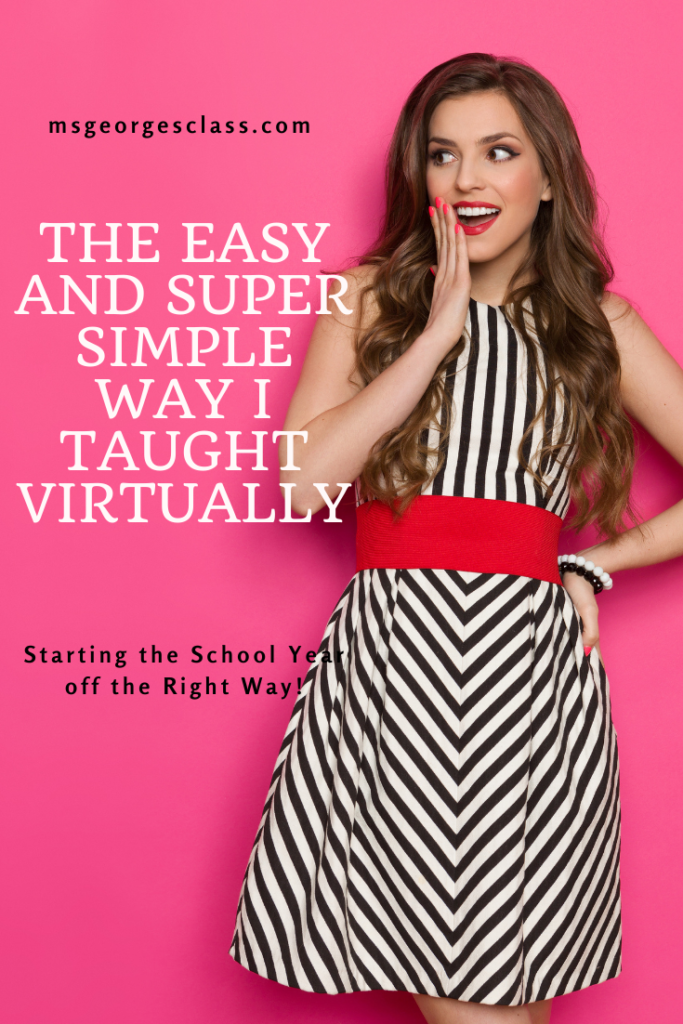Zoom-Online Classrooms

Students come into the room with mics off, and I’m playing light jazz in the background. I was saying hello to each student that was entering the room by their first name, until I had to admit several students at the same time. I announced to the students to turn their videos on and mute their mics. This was the first day of virtual learning. In March, we did virtual learning, but I knew the students, and I had established classroom management. I had rapport with those students and had a system/routine with those students. For virtual learning, I had to learn how to use Zoom, keep students engaged, and have students learning the state standards. Here are some teaching virtually tips I learned that have helped me.
In late August, my school district offered several professional developments for teachers. The city is the fourth largest in Ohio, and we have over twenty schools within the school district. I took advantage of the courses that were offered and even took the Zoom course twice. I knew that learning was going online using Zoom or Google Meet, and I wanted to know everything I could about it. I learned how to use waiting rooms, breakout rooms, and settings. I really enjoyed using the breakout rooms with my students. In March, I used Google Meet, but I prefer Zoom because of the multiple features. The district provided a checklist that assisted teachers to be prepared for the first day of school. I was able to practice Zoom with other teachers within my building during the two weeks of professional development. I’m glad I did because I was able to share my screen and have “students” in breakout rooms during instructional time.
On the first day of instruction, students came into the Zoom conference to hellos, a video of me, and soft jazz in the background. I allowed two minutes after the designated time before I got started. I introduced myself and provided a slide show to the classes of the class and Zoom expectations. Zoom allowed me to share my slide show with my students. Students were on mute, so I didn’t get any questions or hear any of the normal objections I usually get. However, I could only see a few students at a time while I was presenting my slide show. I had an extra-large screen monitor in the garage that I brought from home. A coworker stated that I could watch my group of students on the second monitor while I presented my slide show (genius!). One issue I came across was a student that was continuously taken off of Zoom. During the class, I would get countless pop-ups about admitting the student. I don’t know if her internet connection was not working well or if it was Zoom. One student aggressively asked about the Google Link at the beginning of class. I quickly stated to him to send me an email because it was not a good time to talk. Zoom isn’t a physical classroom, but if you have a good internet connection, you can have a smooth online class.
Keeping Student Engaged
This year, I am teaching 12th grade English Language Arts, reading lab, and career explorations. I usually teach the lesson while projecting a worksheet but not now. During my 12th grade class, I had to walk them through their online textbook Springboard. It took about thirty minutes to get students to create a username and password and to navigate to the correct page. Although I was sharing my screen, students still moved ahead to Unit 4 instead of Unit 1 of the textbook. I repeatedly used the thumbs up/down assessment to make sure students knew what to do. Some students were able to share their screen to show the steps they took to get to the correct page. They also turned their mics on to read passages or describe images.
My career exploration classes are large, and one class has 37 students. After watching the video of the leader teacher introducing SMART goals, I had students read an article during the Zoom and write a summary. They read the article on the computer, and I had them attend breakout rooms. I visited the breakout rooms and found the students talking about the article. When we gathered as a whole group, I instructed the students to write a summary on a Google Doc that I provided in Google Classroom. Many of my seniors completed the 60-word summary and the creation of three SMART goals. I gave a compliment to one of the summaries I quickly viewed, and the student gave a thumbs-up. Thumbs up/down works! I also plan to use my response card more in future classes. A response card is a paper that has yes/no, agree/disagree, multiple-choice answers: A, B, C, D, and E, and shapes. Dr. Anita Archer presented a professional development on how to keep students engaged using choir reading and infused notetaking. To keep students engaged on Zoom, you have to think out of the box.

Teaching Virtually Tip: State Standards
Teaching state standards requires more emphasis during virtual learning. We are teaching on a blocked schedule, which excludes Friday. For high school students, we are meeting 150 minutes versus the 250 minutes a week. As of today, students will have to take the state test ( I live in Ohio, and it’s the OST) and any other college admission test. The pressure is on for our students to do well on the tests, and we must cover the items from the pacing guide. Each department met on Friday on a Zoom conference to discuss the state standard we are going to cover and how we are going to teach it. We were given one standard, two videos from the lead teachers introducing the standard, and time for discussions in breakout rooms. Our standard was “Cite strong and thorough textual evidence…” and we agreed on using literary reading passages to have students identify strong evidence and quotes using the lead teacher’s example. The goal is to have the students work on one standard per week with two videos. Later next week, the students will watch another video discussing how to cite evidence using MLA format.
The lead teachers are using the state standards and the pacing guide to create lessons. My school uses the worktext Springboard while the other high school uses Collections. We may not use the same textbook, but we should be teaching the same skill so that students may be successful. I also noticed that lead teachers are breaking down the standards into chunks and teaching them in two or three lessons. I like that idea because students have more time to focus on a specific area of the standard. Unfortunately, I think the classes are too short and students don’t have enough time to work on the lesson. For example, I had to shorten the getting to know you activities to begin the video, and students had more homework to do because they were unable to finish it in class. The goal is to have students accomplish the state standard with a passing rate in the classroom, the OST, and the college admission test.

Online learning has its own challenges. You have to ensure that students are learning the state standards with limited time, they are engaged and want to come to class, and you are properly using Zoom or another online platform properly. Although I have teacher leader videos and Fridays without students, I still have teacher worries. Will I be evaluated based on how well students test or know the standards? If my students need extra help or an extension on a lesson, how will I address it? I can honestly say that I prefer face to face teaching, but until then, I am going to work hard to make sure my students get the best online learning experience I can provide. This is the beginning of the quarter for me. I’ll let you know if I was able to conquer all the expectations at the end and how these teaching virtually tips worked out for me.
Tell me in the comment section below how you teach online and if you are doing virtual learning.




Leave a Reply